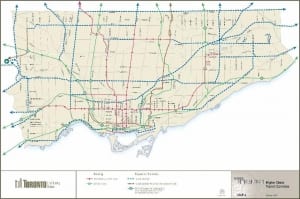Feb. 14, 2020 NRU Toronto newsletter highlights City of Toronto official plan review regarding transportation policies
The current post adds to a previous discussion regarding land use planning issues in southern Etobicoke.
As I’ve noted previously, I subscribe to the Novae Res Urbis (NRU) Toronto newsletter.
Previous posts about NRU include:
NRU Toronto newsletter shares details regarding Toronto’s official plan five-year review
and
NRU is a subscription newsletter
Given that Novae Res Urbis is a subscription newsletter, I’m not going to quote directly from it. For subscription details, please refer to link in previous sentence.
I am pleased, with regard to this valuable information source, to share a quick summary of a Feb. 14, 2020 NRU Toronto article by Rob Jowett entitled “Official plan review: Amending city transportation policies.”
The article notes that at its Feb. 27, 2020 meeting Toronto council will consider an official plan amendment regarding transportation policies as part of the city’s official plan review.
The amendment proposed by city staff is described as building on a set of transportation policy amendments approved in 2014.
It’s also described as focusing on integration of transportation and land use planning – while desisting (from what I can gather from the NRU article) from defining where the city is directing its growth.
As well, it’s described as identifying where higher order transit routes can be potentially extended.
An architect/urban designer is quoted as saying the lack of concrete implementation steps could propose a challenge to achieving the goals within the proposed amendment.
Concerns expressed by community groups in Long Branch and Mimico
Concerns expressed by residents of Long Branch and Mimico are highlighted in the NRU article, which refers to communications to the city from local groups arguing that Lake Shore Blvd. West between Legion Road and the Long Branch loop should not be included in the amendment without a specific implementation plan.
The NRU article also mentions previous studies of higher order transit along this stretch of roadway, which are described as indicating that such a transit corridor is unnecessary.
The article refers, as well, to concern regarding real estate speculation and development in anticipation of such higher order transit (whether or not such a corridor actually gets built).
A city planner is indirectly quoted as saying the routes identified in the amendment including along Lake Shore Blvd. West are intended to protect transit corridors for potential expansion, and is indirectly quoted as expressing the belief, that policies alone would not be sufficient to justify big land use changes.
This concludes my quick overview.
Previous posts regarding topic at hand
Previous posts addressing related topics include:
Map from proposed official plan amendment indicates proposed higher order transit corridor along Lake Shore Blvd. West

Figure 1 – Map 4 – Higher Order Transit Corridors – Draft of Official Plan Amendment, City of Toronto, October 2019. Click on map to enlarge it.
The map at the current post is from p. 23 of Draft Official Plan Amendment – City of Toronto. Click on the map to enlarge it.
The text at bottom of map, going left to right, refers to the City of Toronto Planning Division.
The red line with red dots refers to existing TTC subway and LRT lines. The green lines with green dots refers to existing GO train lines.
The next category refers to proposed expansion elements. The blue dotted line refer to proposed transit corridors.
The dark purple dotted line refers to “Transit corridor alignment to be determined.”
The green encircled dots refer to GO stations on existing lines. It is noted that “Some stations on expansion elements are identified in Secondary Plans.”

Leave a Reply
Want to join the discussion?Feel free to contribute!